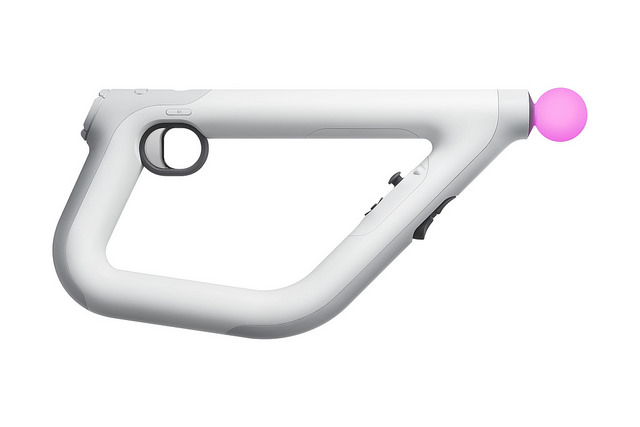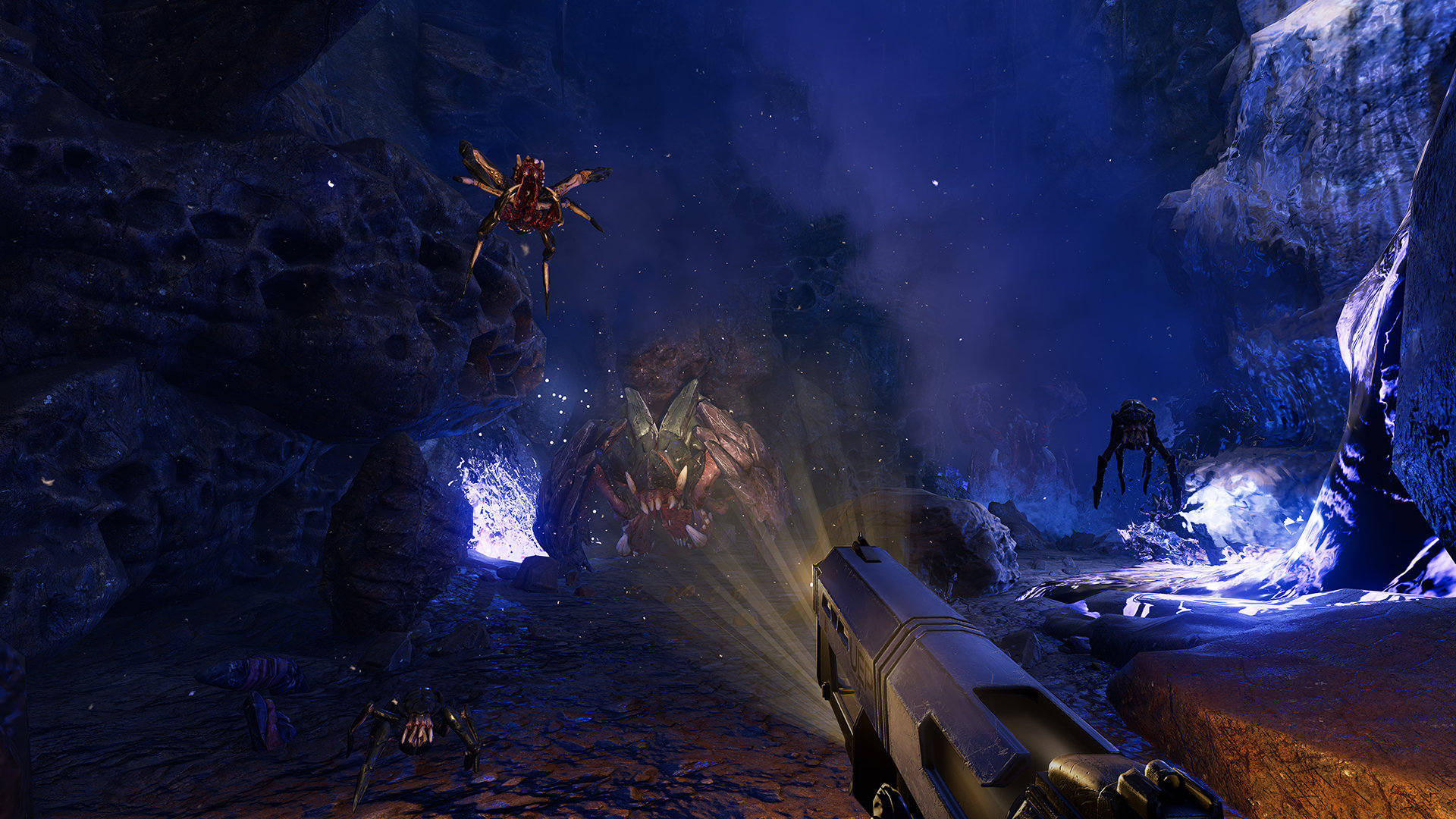Farpoint for PlayStation VR gave me virtual reality shellshock – and I loved it
Shooting the Spiders from Mars (and then running for my life)

Bowie never sang about shooting The Spiders From Mars in the mandibles, did he? Because he should have. If my time with Farpoint on Sony’s PlayStation VR headset has taught me anything, it’s that you should be prepared to be terrified by anything and everything once it’s made the jump into virtual reality.
It’s been a long time coming, but Farpoint VR is effectively the first ‘triple AAA’ title for Sony’s PlayStation 4 virtual reality platform. DriveClub and Batman: Arkham VR were both great, but the former was an existing game reworked for VR, while the latter was too short to be considered a true triple AAA. Robinson: The Journey had potential – until it made us too motion-sick to play through. Farpoint has all the production values, and none of the above barriers to entry.
What it does have, however, was action so intense that it left me trembling like Tom Hank’s hand in Saving Private Ryan. Virtual reality has the power to leave you shellshocked – that’s not necessarily a bad thing, and Farpoint VR is all the better for it.
From hero to zero
Farpoint VR is essentially Starship Troopers: The Virtual Reality game. One a mission to explore a space anomaly near the planet Jupiter, you’re accidentally propelled through some kind of warphole and transported to a Mars-like planet where Spider-like alien creatures want to dine on your fleshy bits. Armed with the new PS VR Aim controller, Sony’s new VR compatible lightgun, you’ll explore alien landscapes, blasting anything that moves.
The gun itself is comfortable and easy to use. It includes all the buttons you'd find on the standard DualShock 4, barring the touchpad, and the placements of all of them are well-considered and ergonomic. I'm not sure if it will see widespread adoption outside of Farpoint (it's an accessory for an accessory after all), but it adds something that the Move controllers themselves otherwise lack.
I’m not a coward, or at least I didn’t think I was. I don’t play many horror games (not that Farpoint is marketed as one in any case), but I’m fine with a horror film. I merely tolerate spiders, but aren’t actively freaked out by them, and find the prospect of exploring uncharted alien worlds quite exciting. Farpoint, however, shattered any illusions that I have what it takes to be a hero. It left me positively stunned.
Immersion is the key to a great VR game, and it’s what makes Farpoint so successfully shocking. It’s one of the best-looking PlayStation VR games we’ve seen so far. The swirling sands of this particular red planet sweep up a storm, the rock faces are dramatically imposing and the space anomalies sparkly and alluring.
Sign up for breaking news, reviews, opinion, top tech deals, and more.
Farpoint, however, shattered any illusions that I have what it takes to be a hero.
And then there’s the spiders. You think you’re all-powerful when you’re towering over them with a glass tumbler in the real world, but it’s another story when you’re stuck in their virtual realm. That whole “they're more scared of you than you are of them” thing is totally not true when they’re 12 feet tall, armoured like tanks and charging at you.
VR's emotional impact
Farpoint is a perfect example of how, when done correctly, virtual reality can elevate the emotional impact of a gaming experience tenfold. Its core gameplay – being a free-roaming lightgun shooter, with smatterings of narrative, some strong set pieces and solid wave-based shooting – isn’t hugely inspired.

It’d be enjoyable enough in an arcade-y sort of way when played on a TV, but in VR, when you’re placed in the center of the action, with positional audio and your body and weapons recreated in digitally in front of you, it’s suddenly an experience totally transformed. Your pulse quickens, your palms sweat, and the enemies that normally wouldn’t phase you become monstrously disquieting.
It made me feel very bad for all the avatars I routinely send to their dooms in non-VR titles.
On a technical level, beyond its high quality visual fidelity, Farpoint works marvellously well too. I’m not sure how it gets away with it, but it’s able to use techniques that have made other virtual reality titles a nauseating mess and get away with it unscathed.
It made me feel very bad for all the avatars I routinely send to their dooms in non-VR titles.
Primarily, it’s the way you control movement in the game that left me pleasantly surprised – as well as triggers and buttons that correspond with the DualShock pad’s buttons, the PS VR Aim controller includes two thumbsticks, one which controls locomotion, with the direction of travel controlled by where you point your head. In every other game that I’ve tried this movement style with, it’s only been ten minutes or so before I’ve started feeling a bit sea sick. But with Farpoint, even when strafing, I didn’t feel uncomfortable.
A bullseye for PS VR Aim
I can’t pinpoint why this is possible (motion sickness is usually tied to the disconnect between seeing movement that doesn’t correspond with your body’s own movement), but it may be down to things.
Firstly, Farpoint’s level structure and narrative encourages you to constantly move forwards. You’re free to go backwards, or turn anywhere in that 360-degrees circle of rotation, but there’s little reason to backtrack. Indeed, if an enemy has got behind you, chances are you’ll be dead before you can effectively react anyway. You may have freedom of movement, but the linear path and action may be a subtle way of encouraging you not to.

Secondly, there’s the PS VR Aim controller itself – as a near-constant, more-or-less fixed point in your vision, it gives you a focus point to center around. Just as the Battlefront Star Wars: VR X-Wing mission used the ship’s cone to settle your stomach, perhaps the PS VR Aim controller is having a similar effect.
The PS VR Aim controller is worthy of praise in its own right. DualShock control is optional, but the Aim controller is a million times more fun. Farpoint’s being primarily marketed with it as a packed-in accessory anyway (making for a pricey, but justifiable $79.99 / £74.99 price tag), and it’s really the optimal way to enjoy the game. Essentially a frame with a PlayStation Move controller attached to one end, you’re encouraged to hold it in such a way that, through the magic of VR, the developers can convincingly turn it into any number of weapons in-game.
They use this, and the built in rumble capabilities, to great effect, offering holographic iron-sights that you can physically (digitally?) peer through on a machine gun, while letting you steer missiles to their targets with a laser-guided trail for a secondary weapon. Comfortably weighted and rumbling convincingly depending on the weapon in your hand, it’s a great peripheral that will hopefully be paired with plenty of fresh titles.
The future of the FPS?
I’ve yet to finish Farpoint, or had the pleasure to tackle it’s two player co-op action yet – it’s a horde mode, one which I’d imagine offsets the arachnophobia with the soothing screams of your online partner. But I’m itching to jump back in – if I can keep the terror-sweat from short-circuiting the whole headset.

It’s got all the makings of a must-have game – provided you have a PlayStation VR headset of course, seeing as it’s a Sony platform exclusive. But if Farpoint achieves nothing else, it should be as proving a big-budget shooter would work fantastically in VR. Reskin this with some Stormtroopers or (gulp) some Alien Xenomorphs, and it’d be a license to print money.
The FPS genre has been in need of revitalising for some time. Forget the WWII reboots – Farpoint shows that devs should be shooting for the VR stars.

Gerald is Editor-in-Chief of Shortlist.com. Previously he was the Executive Editor for TechRadar, taking care of the site's home cinema, gaming, smart home, entertainment and audio output. He loves gaming, but don't expect him to play with you unless your console is hooked up to a 4K HDR screen and a 7.1 surround system. Before TechRadar, Gerald was Editor of Gizmodo UK. He was also the EIC of iMore.com, and is the author of 'Get Technology: Upgrade Your Future', published by Aurum Press.